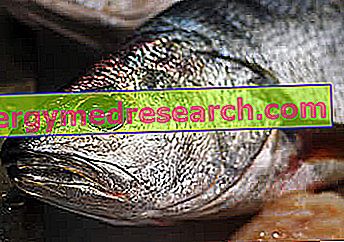Generality
Ombrina is a bony sea fish, belonging to the Sciaenidae family and to the Genus Umbrine (binomial nomenclature: Umbrina cirrosa ).

The nutritional properties of the shadow are remarkable. Contains few calories, many proteins and "healthy fats"; its meats abounding in vitamin D and some in group B.
From an ecological point of view, the shadow is currently classified as an endangered species.
Nutritional Features
Ombrina is a product that belongs to the fundamental group of foods. Its dietary function is to provide essential amino acids and lipids, certain mineral salts and some vitamins.
The energy intake of the shadow is reduced; calories are supplied mainly by proteins, followed by few fatty acids and (simple) carbohydrates.
Ombrine peptides have a high biological value.
Triglycerides have an excellent percentage of omega 3 (eicosapentaenoic acid or EPA and docosahexaenoic acid or DHA), even if the total quantity is moderate.
Ombrina does not contain dietary fiber, phytic acid and ethyl alcohol. Instead it has a fair concentration of cholesterol.
Among the vitamins, the most important ones are the water-soluble PP or B3 (niacin) and the liposoluble D (calciferol). There are no particularly high levels of iron or calcium. Being a sea product, it should contain a good concentration of iodine.
From the nutritional point of view, the umbrina is a food that lends itself to any ordinary diet.
It is not among the foods most frequently responsible for food allergy and has no contraindications for celiac or lactose intolerant.
It is recommended in the diet of the obese and those suffering from metabolic diseases: hypercholesterolemia, hypertriglyceridemia, type 2 diabetes mellitus, arterial hypertension and metabolic syndrome.
Thanks to its high digestibility, the umbrina is a useful product for clinical nutrition and food therapy against certain conditions or diseases of the digestive tract. In particular: esophageal, gastric and duodenal suffering (esophagitis, gastroesophageal reflux, hiatal hernia, gastritis, gastric or duodenal ulcer, etc.), hepatic or pancreatic compromises (partial insufficiency, cholecystectomy, etc.).
Ombrine can also be eaten two or three times a week, as it does not contain high levels of mercury.
If eaten raw, it is necessary to subject it to a lowering of the temperature to avoid the risk of anisakis infestation. In pregnant women it is absolutely advisable to consume it only when cooked.
Thinned accurately, the shadow can re-enter the feeding of the infant and replace the hake, cod or plaice. Until the end of the second year, it is advisable to prepare it boiled and with a little extra virgin olive oil.
The average portion is approximately 150-200g of edible portion (about 300-400g of whole fish to be cleaned).
 | ||
| Chemical composition | Value for 100g | |
| Edible part | - | |
| water | 80, 0g | |
| Protein | 17, 2g | |
| Limiting Amino Acid | - | |
| Total lipids | 0.5g | |
| Saturated fatty acids | 0, 09g | |
| Monounsaturated fatty acids | 0, 14g | |
| Polyunsaturated fatty acids | 0, 40g | |
| Cholesterol | 57, 0mg | |
| Carbohydrates available | 0.8g | |
| Starch | 0.0g | |
| Soluble sugars | 0.8g | |
| Total fiber | 0.0g | |
| Soluble fiber | 0.0g | |
| Insoluble fiber | 0.0g | |
| Phytic acid | 0.0g | |
| Alcohol | 0.0g | |
| Power | kcal | |
| Sodium | 120, 0mg | |
| Potassium | 280, 0mg | |
| Iron | 0.4mg | |
| Football | 15, 0mg | |
| Phosphorus | 92, 0mg | |
| Magnesium | - mg | |
| Zinc | 0.4mg | |
| Copper | - mg | |
| Selenium | - µg | |
| Thiamine | 0, 23mg | |
| Riboflavin | 0, 10mg | |
| Niacin | 4, 50mg | |
| pyridoxine | 0, 19mg | |
| Vitamin A retinol eq. | - | |
| C vitamin | - | |
| Vitamin E | 0, 40mg | |
| Vitamin D | 80, 0IU | |
Gastronomic outline
Ombrina is a fish with highly appreciated meats.
Cruda has a good consistency and a delicate flavor. Cotta has an intense aroma, more pronounced than the sea bream or sea bass.
It is suitable for any cooking technique but it is essential to keep in mind that the percentage of fat is rather low (similar to that of cod). The thinness of the meat makes it more susceptible to dehydration; in practice, it tends to dry easily.
Who does not have much experience in the kitchen but prefers to cook it roasted, should avoid the irradiation system (charcoal grill) and approach it with simpler methods, for example: on the plate, in the oven in natural or in foil.
Another characteristic of the shadow is the tendency to break easily; it is advisable to be careful in handling during and after cooking.
It is a medium spiny fish but, like sea bream or sea bass, it can be easily filed.
The raw preparations include carpaccio and tartare in the natural state or with light marinades; excellent combination with spices and aromas such as: lime, dill, thyme, marjoram and pink pepper.
Cooked preparations include recipes with delicate and non-overlying ingredients; in particular: frying pan (in the water crazy or simple), boiling (in water or steam), braising in fish sauce, roast in the oven, in a crust of salt or vegetables (mixed or only potatoes) and roasted on the grill. It is very suitable for vasocottura.
The elitist condiments are extra virgin olive oil and delicate sauces.
Biology and Ecology
Description
The shade has a moderately elongated, deep and compressed body.
The mouth is small, facing down and provided with villiform teeth.
Short and stiff barbels appear under the jaw.
The caudal fin is truncated and slightly marginalized. The two dorsal fins are joined. Two pectoral fins are deduced, two ventral and one anal.
The skin color is silver-gray tending to brownish, with a metallic hue and longitudinal dark lines; the fins are darker.
Fishing and Commerce
Ombrina is considered a product of "minority" fishing. This appellation does not concern the gastronomic value of the meat (remarkable) but rather the economic role it has.
The professional capture of the umbrina is mainly carried out with the gillnets and the trawl. It is also interested in recreational fishing.
The commercial demand of the umbrella is partly satisfied by the breeding. However, the wild population continues to decline (-50% in 15 years), highlighting an over-exploitation of natural fish resources, dangerously high levels of pollution and the destruction of ecological niches.
Distribution and Habitat
The Ombrina colonizes the Mediterranean basin, the Black Sea, the Azov Sea and the Eastern Atlantic (from the Bay of Biscay in the south of Morocco).
It frequents bathymetrics between 0 and 100m and lives on sandy, rocky or partly clay bottoms.
It mainly occupies coastal waters and sometimes enters the river estuaries.
Habits and Reproduction
It spends most of the time near the bottom, where it feeds on small invertebrates (molluscs, worms and small fish).
Gets sexual maturity at 35cm in length and reproduces between May and June.
It reaches a maximum variable size depending on the picking area (70-100cm in length and 3-12kg in weight). The average size is 40cm (5 years); catches of larger specimens are not uncommon.
NB . The Boccadoro shadow belongs to different genus and species ( Argyrosomus regius ) and reaches a much larger size (230cm for over 100kg).



